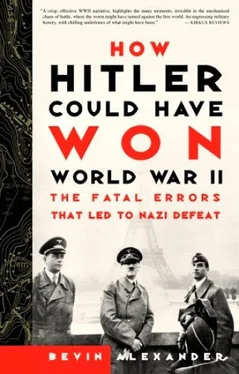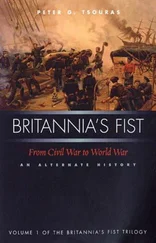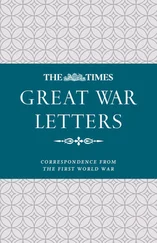Until the summer of 1940, Hitler had run up a string of victories that were unprecedented in world history. He achieved most of them by the application of his remarkable political skills, and without the use of force.
Over the course of six years, beginning with his assumption of the chancellorship of Germany on January 30, 1933, Hitler got himself elected dictator of Germany less than two months later and put the state wholly under the Nazi party which he led; withdrew Germany from the League of Nations in October 1933; commenced massive secret rebuilding of German military power in 1934; introduced conscription in violation of the Versailles treaty in 1935; reoccupied the Rhineland in 1936, a German border region demilitarized under terms of the Versailles treaty; declared the treaty dead in 1937; seized the sovereign state of Austria and joined it to Germany on March 10, 1938; bullied the leaders of Britain and France into accepting his dismemberment of Czechoslovakia at the Munich conference, September 29–30, 1938, and occupied the remaining rump of the state—the Czech portions of Bohemia and Moravia—on March 15, 1939.
It was this last act of treachery that finally showed Neville Chamberlain, British prime minister, and Edouard Daladier, the French premier, that their policy of “appeasement” of Hitler was utterly misguided and that Hitler was a congenital liar. At Munich, Hitler had solemnly sworn that his final territorial aspiration in Europe was annexation of the Sudetenland, the German-speaking part of Czechoslovakia, and that he would assure the independence of the remainder of the state.
Britain and France now guaranteed the independence of Poland, the next victim on Hitler’s list. It was a hopeless gesture, since neither country could help Poland. That country’s fate was sealed on August 23, 1939, when the Soviet Union signed a nonaggression pact with Germany— inspired not by confidence in the peaceful intentions of Hitler but by desperation. Britain and France, who feared Communism, had refused to work with the Soviet Union to block Hitler during the early years when he could have been stopped with relative ease.
Bolstered by secret provisions of the Berlin-Moscow pact, which divided eastern Europe into German and Soviet spheres of influence, Hitler launched his armies against Poland on September 1, 1939. Poland had no chance whatsoever, being half-surrounded by German or German-held territory. The Polish army was enveloped from the first day. In addition, German General Heinz Guderian had developed a spectacular panzer arm, and German tanks cut through and rolled up Polish defenses with ease and unimagined speed in the first application of Blitzkrieg, or “lightning war.” Within three weeks Poland was defeated—and the Poles found their land partitioned between the Germans in the west and the Soviets in the east.
Britain and France declared war on Germany on September 3, 1939. The British took some action at sea, blockading German ports and pursuing German surface raiders, but were slow to put troops on the Continent, while France did virtually nothing on the Franco-German frontier. The fall and winter of 1939–1940 became known in the British Empire and the United States as the “phony war,” in France as the drôle de guerre, and in Germany as the Sitzkrieg.
Meanwhile, the Soviet Union took advantage of its pact with Germany to demand from Finland large cessions of territory as a buffer around the city of Leningrad (St. Petersburg) and elsewhere. The Finns refused and Soviet troops invaded on November 30, 1939. The Finns performed brilliantly in the “winter war,” but Soviet power was too great. Russians breached the main Finnish defensive line on February 11, 1940, and Finland capitulated on March 12, ceding the land Russia wanted.
The Allies—Britain and France—saw a chance to damage the German war economy by mining the territorial waters of Norway to prevent shipment of iron ore from northern Sweden during the winter through the Norwegian port of Narvik. This ore was vital to the German war effort, but could not be moved by way of the Baltic Sea in winter because the Gulf of Bothnia froze over. At the same time Hitler coveted the deep fjords of Norway as protected places to launch German surface ships, aircraft, and submarines against British supply lines. Both sides began plans early in 1940 to occupy Norway.
Hitler struck first, seizing Denmark in a swift coup de main and occupying key ports of Norway on April 9, 1940. The Allies contested the occupation of Norway and scored some successes, especially at sea. But German efforts were more ordered and decisive, and Allied forces soon withdrew, especially as the focal point of the war shifted to the Low Countries of Belgium, Holland, and Luxembourg and to France where Hitler launched his campaign in the west on May 10, 1940.
The Polish campaign should have tipped off the Allies to new uses for two elements in the German arsenal. But it did not, and they hit the Allied forces in the west like a thunderbolt. The elements were the airplane and the tank.
German generals had discovered something that the leaders of other armies had not figured out—that airplanes and tanks were not weapons but kinds of vehicles. Vehicles could carry armor, guns, or people, making possible an entirely new military system built around them. Armies could consist of troops carried by airplanes or dropped from them, or of self-propelled forces containing tanks, motorized artillery, and motorized infantry. Air forces could include tactical aircraft, such as dive-bombers, that functioned as aerial field artillery, or strategic aircraft with long-range and heavy bomb-carrying capacity that could bomb the enemy homeland.
Heinz Guderian had built the panzer arm on the teachings of two English experts, J. F. C. Fuller and Basil H. Liddell Hart, whose ideas of concentrating armor into large units had been largely ignored in their own country. The German high command was as hidebound as the British leadership on this point, and fought Guderian’s ideas. It was the enthusiasm of Hitler for tanks that gave Guderian the opening to establish the army doctrine of putting all armor into panzer divisions, instead of dividing it into small detachments parceled out to infantry divisions, as remained the practice in the French and British armies.
In addition, Guderian won acceptance of the doctrine that panzer divisions had to be made up not only of tanks but of motorized infantry, artillery, and engineers, who could move at the speed of tanks and operate alongside armor to carry out offensive operations wherever the tanks could reach.
Erwin Rommel, who would become famous for his campaigns in North Africa, produced the best one-sentence description of blitzkrieg warfare: “The art of concentrating strength at one point, forcing a breakthrough, rolling up and securing the flanks on either side, and then penetrating like lightning deep into his rear, before the enemy has had time to react.”
This was a revolutionary idea to the armies of the world. Most military leaders thought tanks should be used as they had been employed in World War I—to assist infantry in carrying out assaults on foot against enemy objectives. For this reason, the best Allied tanks, like the British Matilda, were heavily armored monsters that could deflect most enemy fire but could move scarcely faster than an infantryman could walk. German tanks, on the other hand, were “fast runners” with less armor, but able to travel at around 25 miles an hour and designed for quick penetration of an enemy line and fast exploitation of the breakthrough thereafter into the enemy rear.
It is astonishing that Allied (and most German) generals did not see the disarming logic of Guderian’s argument. He pointed out, for example, that if one side had 2,100 tanks and dispersed them evenly across a 300-mile front to support its infantry divisions, the tank density would be seven per mile, not enough to be decisive except in local engagements. If the other side had the same number of tanks and concentrated them at a single Schwerpunkt, or main center of attack, the density would be as many tanks as could physically be fitted on the roads and fields in the sector. Such a concentration would be bound to break through. Defending tanks and antitank guns would be too few to destroy all the attacking armor, leaving the remainder to rush into the rear, with other motorized forces following to exploit the victory. This would inevitably destroy the equilibrium of the main line of resistance and force the entire front to disintegrate.
Читать дальше


![Джонатан Димблби - Barbarossa - How Hitler Lost the War [calibre]](/books/385421/dzhonatan-dimblbi-barbarossa-how-hitler-lost-the-w-thumb.webp)









